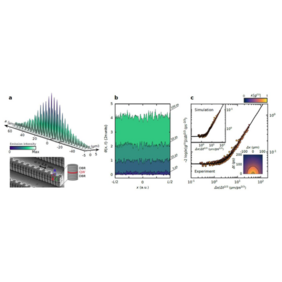Coherent light reveals universal behavior, a study published in Nature magazine of which Alberto AMO is co-author.
DYSCO Vie du labo Parutions
Universality is a powerful concept in statistical physics that allows critical phenomena to be understood and effectively described based on a few fundamental ingredients. Thus, systems as different as a crystalline surface, frost on a window, or the skyline of a modern city subject to building constraints, can all be described in a simplified way as an interface of height h(r ,t) whose dynamics is governed by the same non-linear stochastic equation called the Kardar-Parisi-Zhang (KPZ) equation, after the 3 physicists who introduced it for the first time in 1986 [1]. This very simple equation is extraordinarily rich. It predicts the development of spatio-temporal correlations in the height of the interface: the height observed at a time t and at a position x depends on what was observed earlier, at t=0 and at x=0. Thus self-similar structures develop in time and space with universal critical exponents that depend only on the dimensionality of the interface. It is these structures that make the beauty of frost.
An international team of researchers has just demonstrated experimentally that the KPZ universality class is also present in photonic systems, an effect theoretically predicted in 2015 [2]. This universality manifests in the spatiotemporal phase correlations of a polariton laser created in a one-dimensional array of micropillars. The phase of light emitted at different points in the grating plays the role of interface height in KPZ physics.
The experimental and theoretical efforts of this work were carried out by the teams of Jacqueline Bloch at the Center for Nanosciences and Nanotechnologies, and of Anna Minguzzi and Léonie Canet at the Laboratory of Physics and Modeling of Condensed Media (LPMMC) in Grenoble, with contributions by Alberto Amo from the PhLAM laboratory.
References
Kardar–Parisi–Zhang universality in a one-dimensional polariton condensate
Fontaine, Q., Squizzato, D., Baboux, F. et al.
Nature 608, 687–691 (2022)
News and Views : A new phase for the universal growth of interfaces
DOI : doi.org/10.1038/s41586-022-05001-8
[1] Kardar, M., Parisi, G. & Zhang, Y.-C., Dynamic scaling of growing interfaces, Physical Review Letters 56, 889 (1986).
[2] Altman, E., Sieberer, L. M., Chen, L., Diehl, S. & Toner, J., Two-dimensional superfluidity of exciton polaritons requires strong anisotropy, Physical Review X 5, 011017 (2015).
Figure (available in "Related Resources" below):
a. Experimental measurement of the light intensity distribution emitted by the condensate (top thumbnail). The bottom thumbnail shows a scanning electron microscopy image of Experimental measurement of the light intensity distribution emitted by the condensate (top thumbnail). The bottom thumbnail shows a scanning electron microscopy image of a 1D array of polariton microcavities.
b. Calcul numérique de la phase d’un condensat 1D de polaritons à différents instants. L’évolution temporelle de la phase est analogue à la croissance d’une interface.
c. Dans un système de coordonnées redimensionnées bien choisi, les points mesurés expérimentalement et calculés numériquement pour la cohérence du condensat (disques de couleur orangée) s’alignent parfaitement sur la courbe universelle de KPZ (courbe noire).

